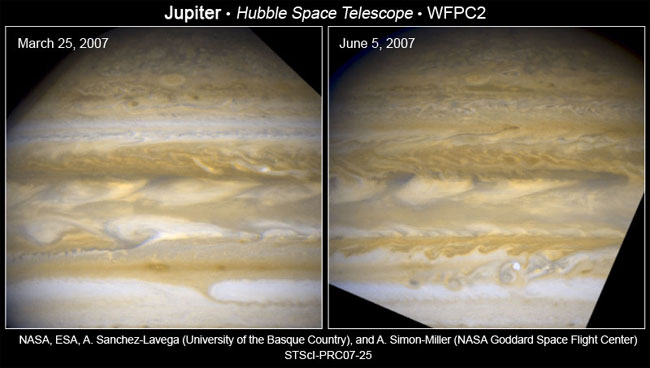Hubble Watches As Jupiter Changes Stripes

Clouds on Jupiter have been caught swapping places, changing their shapes and colors as lower clouds move up and higher clouds sink.
Jupiter is wrapped in cloudy strips of yellows, browns and whites, created by winds at various latitudes blowing in different directions. Propelled by speedy winds, the clouds whip around the planet at hundreds of miles per hour.
High elevation clouds reside in “belt” regions of the Jovian atmosphere. Belt clouds are darker than those flying in the relatively low-elevation “zone” regions of the atmosphere. The winds in belts and zones flow in opposite directions.
Between March 25 and June 5, NASA’s Hubble Space Telescope witnessed zones darkening into belts and belts lightening and transforming into zones. Clouds rapidly changed shapes and sizes.
The images, released today, show a thin band of high-elevation clouds above Jupiter’s equator sinking through the atmosphere and turning brown. The clouds also morph from small squiggles into large wave-shaped features.
Below the equator, a giant tan-colored cloud shaped like an upside-down shark fin disappears, making way for numerous white swirls that take its place.
The transformation was caught by the space telescope’s Wide Field and Planetary Camera 2. Such global upheavals have been seen before, but not with Hubble’s sharp resolution.
Breaking space news, the latest updates on rocket launches, skywatching events and more!
- The Worst Weather in the Solar System
- Differences Spotted in Jupiter's Big Red Storms
- Jupiter's Cloud Bands Driven by Thunderstorms, Study Suggests

Space.com is the premier source of space exploration, innovation and astronomy news, chronicling (and celebrating) humanity's ongoing expansion across the final frontier. Originally founded in 1999, Space.com is, and always has been, the passion of writers and editors who are space fans and also trained journalists. Our current news team consists of Editor-in-Chief Tariq Malik; Editor Hanneke Weitering, Senior Space Writer Mike Wall; Senior Writer Meghan Bartels; Senior Writer Chelsea Gohd, Senior Writer Tereza Pultarova and Staff Writer Alexander Cox, focusing on e-commerce. Senior Producer Steve Spaleta oversees our space videos, with Diana Whitcroft as our Social Media Editor.
